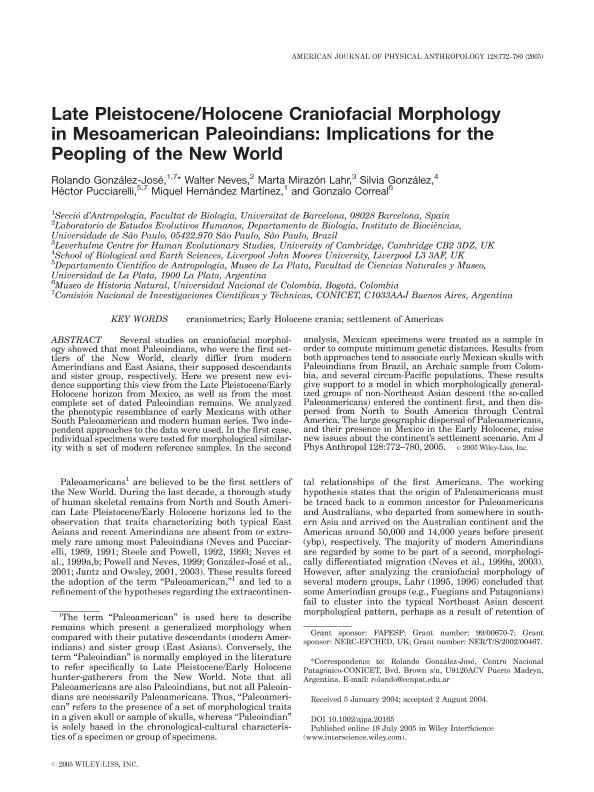Artículo
Late Pleistocene/Holocene craniofacial morphology in Mesoamerican Paleoindians: Implications for the peopling of the New World
González José, Rolando ; Neves, Walter; Lahr, Marta Mirazón; González, Silvia; Pucciarelli, Hector Mario
; Neves, Walter; Lahr, Marta Mirazón; González, Silvia; Pucciarelli, Hector Mario ; Martínez, Miquel Hernández; Correal, Gonzalo
; Martínez, Miquel Hernández; Correal, Gonzalo
 ; Neves, Walter; Lahr, Marta Mirazón; González, Silvia; Pucciarelli, Hector Mario
; Neves, Walter; Lahr, Marta Mirazón; González, Silvia; Pucciarelli, Hector Mario ; Martínez, Miquel Hernández; Correal, Gonzalo
; Martínez, Miquel Hernández; Correal, Gonzalo
Fecha de publicación:
12/2005
Editorial:
Wiley-liss, Div John Wiley & Sons Inc
Revista:
American Journal Of Physical Anthropology
ISSN:
0002-9483
Idioma:
Inglés
Tipo de recurso:
Artículo publicado
Clasificación temática:
Resumen
Several studies on craniofacial morphology have shown that Paleoindians, who were the first settlers of the New World, clearly differ from modern Amerindians and East Asians, their supposed descendants and sister group respectively. Here we present new evidence supporting this view from the late Pleistocene/early Holocene Horizon from Mexico, as well as from the most complete set of dated Paleoamerican remains. We analyzed the phenotypic resemblance of early Mexicans with other South Paleoamerican and modern human series. Two independent approaches to data were used. In the first case, individual specimens were tested for morphological similarity with a set of modern reference samples. In the second analysis, Mexican specimens were treated as a sample in order to compute minimum genetic distances. Results from both approaches tend to associate the early Mexican skulls with Paleoamericans from Brazil, an archaic sample from Colombia, Australians, Polynesians and Africans and give support to a model in which morphologically generalized groups of non-northeast Asian descent entered the continent first, and then dispersed from North to South America through Central America. The large geographic dispersal of Paleoamericans and their presence in Mexico in the early Holocene, raises new issues about the continent’s settlement scenario.
Archivos asociados
Licencia
Identificadores
Colecciones
Articulos(CCT - LA PLATA)
Articulos de CTRO.CIENTIFICO TECNOL.CONICET - LA PLATA
Articulos de CTRO.CIENTIFICO TECNOL.CONICET - LA PLATA
Articulos(CCT-CENPAT)
Articulos de CTRO.CIENTIFICO TECNOL.CONICET - CENPAT
Articulos de CTRO.CIENTIFICO TECNOL.CONICET - CENPAT
Citación
González José, Rolando; Neves, Walter; Lahr, Marta Mirazón; González, Silvia; Pucciarelli, Hector Mario; et al.; Late Pleistocene/Holocene craniofacial morphology in Mesoamerican Paleoindians: Implications for the peopling of the New World; Wiley-liss, Div John Wiley & Sons Inc; American Journal Of Physical Anthropology; 128; 4; 12-2005; 772-780
Compartir
Altmétricas



